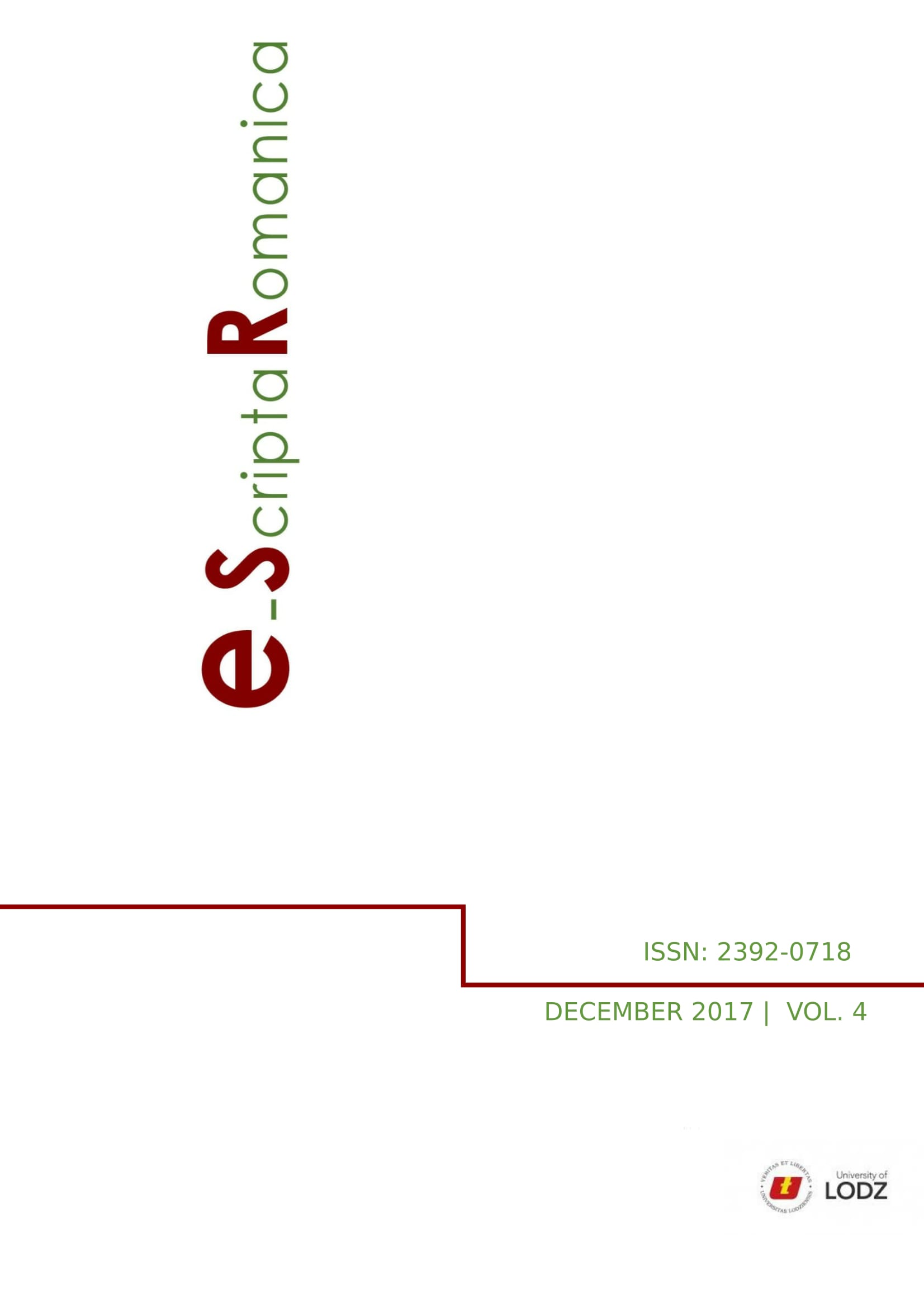Neology and linguistic identity in Mexican Spanish
DOI:
https://doi.org/10.18778/2392-0718.04.10Keywords:
neology, word-formation, productivity, linguistic identityAbstract
From the onomasiological point of view, the process of coining new words is determined by sociocultural and identity aspects of linguistic communities (Štekauer 2005; Körtvélyessy and Štekauer 2014). In the development of a culture, the creation of secondary lexicon is closely related to the historical and social evolution of peoples. It is not surprising that in the varieties of the Spanish language different preferences can be found in the selection of the word-formation process used to name the world. In this paper, we will analyze that processes in Mexico and show that some are typical of this variety of Spanish and reflect current aspects of their society and culture. We will use the neological corpus Morfolex (Zacarías, 2016c), which compiles neologisms formed in Mexico in the last decade. Briefly describe the processes of collection and classification of neologisms and productivity criteria that allow to recognize the favorite word-formation schemes. Finally, it will be shown that among the most productive schemes are suffixes azo, iza, erío; compositional element narco; compound words of name and adjective (N+A), and blends.
References
CABRÉ, T. (2011): “La neología y los neologismos: Reflexiones teóricas y cuestiones aplicadas”. De la lengua por sólo la extrañeza. Estudios de lexicología, norma lingüística, historia y literatura en homenaje a Luis Fernando Lara. M. VÁZQUEZ, K. ZIMMERMANN y F. SEGOVIA (eds.). México: El Colegio de México, pp. 465-487.
Google Scholar
CABRÉ, T. (2016): “Principios y parámetros en una teoría de neologismos”. La neología en las lenguas románicas. Recursos, estrategias y nuevas orientaciones. J. GARCÍA, G. DE STERCK, D. LINDER, N. MAROTO, M. SÁNCHEZ, y J. TORRES DEL REY (eds.). Frankfurt: Peter Lang, pp. 27-42.
Google Scholar
CABRÉ, T., M. BAYÁ et al. (2002): “Evaluación de la vitalidad de una lengua a través de la neología: a propósito de la neología espontánea y de la neología planificada”. Lèxic i Neologia. T. CABRÉ, J. FREIXÁ y E. SOLÉ (eds.). Barcelona: Observatori de Neologia. Institut Universitari de Lingüística Aplicada, Universitat Pompeu Fabra, pp. 159-201.
Google Scholar
CORTÉS, O. (2011): “Formación de palabras y paronomasia”. Lingüística Mexicana 6/1, pp. 37-63.
Google Scholar
FUENTES, M., C. GERDING et al (2009): “Neología léxica: Reflejo de la vitalidad del español de Chile”. Revista de Lingüística Teórica y Aplicada, 47/ 1, pp. 103-124.
Google Scholar
HALLIDAY, M.A.K. (2001): El lenguaje como semiótica social. La interpretación social del lenguaje y el significado. Buenos Aires: Fondo de Cultura Económica.
Google Scholar
KÖRTVÉLYESSY, L. & P. ŠTEKAUER (2014): “Derivation in Social Context”. The Oxford Handbook of Derivational Morphology. R. LIEBER Y P. STEKAUER (eds.). Oxford/New York: Oxford University Press, pp. 407-423.
Google Scholar
LLANOS, L. & M. VILLAYANDRE (2017): “‘Gordibuenas’ y ‘peliteñidos’: la productividad del esquema adjetivo/sustantivo + adjetivo con vocal de enlace en la formación de neologismos”. La renovación léxica en las lenguas románicas: proyectos y perspectivas. M. SÁNCHEZ, N. MAROTO, G. DE STERCK, J. TORRES DEL REY, D. LINDER, y J. GARCÍA (eds.). Murcia: Editum, 433-444.
Google Scholar
MORENO DE ALBA, J. (2013): Notas de gramática dialectal. El Atlas Lingüístico de México. México: UNAM.
Google Scholar
RAMOS, E. (2000): “Elementos Léxicos y Construcción de Identidad en el español de Venezuela”. Fermentum. Revista Venezolana de Sociología y Antropología, 10/29, pp. 421-432.
Google Scholar
REAL ACADEMIA ESPAÑOLA Y ASOCIACIÓN DE ACADEMIAS DE LA LENGUA ESPAÑOLA (2009): Nueva gramática de la lengua española. México: ESPASA. (NGLE)
Google Scholar
REAL ACADEMIA ESPAÑOLA Y ASOCIACIÓN DE ACADEMIAS DE LA LENGUA ESPAÑOLA (2014): Diccionario de la lengua española. México: ESPASA. (DLA)
Google Scholar
SAUCEDO, H. (2011): “Polisemia en la formación de palabras. El caso de la parasíntesis en en- -ar del tipo enlatar”. Lingüística Mexicana, 6, 1, pp. 81-98.
Google Scholar
SCHMID, H. (2011): English Morphology and Word-Formation. An Introduction. Berlín: Schmidt Verlag.
Google Scholar
ŠTEKAUER, P. (2005): “Onomasiological approach to word-formation”. Handbook of Word-Formation. P. ŠTEKAUER Y R. LIEBER (eds.). Dordrecht: Springer, pp. 207-232.
Google Scholar
ŠTEKAUER, P., S. VARELA & L. KORTVÉLYESSY (2012): Word-Formation in the World’s Languages: A Typological Survey. Cambridge: Cambridge University Press.
Google Scholar
YAÑEZ, F. (2014): Prensa y neologismos: La naturaleza adaptativa y creativa del léxico. Tesis doctoral. Madrid: Universidad Nacional de Educación a Distancia.
Google Scholar
ZACARÍAS, R. (2015): “Análisis morfológico y semántico del sufijo -iza y sus implicaciones lexicográficas”. Signo y Seña, 27, pp. 247-266.
Google Scholar
ZACARÍAS, R. (2016a): “Rivalidad entre esquemas de formación de palabras”. Publicaciones del Centro de Lingüística Hispánica Juan M. Lope Blanch, 62. México: UNAM.
Google Scholar
ZACARÍAS, R. (2016b): “Análisis morfológico, semántico y lexicográfico del sufijo -erío en el español de México”. Thesaurus. Revista del Instituto Caro y Cuervo, 58, pp. 30-52.
Google Scholar
ZACARÍAS, R. (2016c): “Morfología léxica en el español actual de México: neología y productividad”. Estudios de Lingüística Aplicada, 34/64, pp. 11-31.
Google Scholar
Downloads
Published
How to Cite
Issue
Section
License

This work is licensed under a Creative Commons Attribution-NonCommercial-NoDerivatives 4.0 International License.











